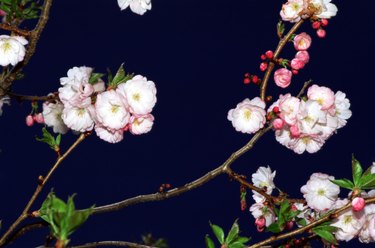Things You'll Need
Soil test kit
Organic matter
Nitrogen fertilizer (optional)
Organic mulch

The crabapple tree (Malus species) adorns yards and gardens with its spring blossoms and distinctive shape. Although sizes vary based on species and cultivar, most trees measure less than 25 feet with a similar width, with shrub cultivars also available. Spring blossoms range from snowy white to red, based on the species and cultivar, and mature into fruits in the summer. Although edible, crabapple fruits require cooking and sweetening. To enjoy its plentiful blossoms and fruits and to reduce risk of disease, you should properly fertilize your crabapple tree.
Step 1
Collect a soil sample and submit it for testing. Your local cooperative extension office can test your soil or recommend a private testing lab. Soil tests will determine the levels of organic matter and important nutrients, the soil pH and the soil texture and will provide fertilizer recommendations.
Video of the Day
Step 2
Incorporate organic matter, such as leaf litter or sphagnum peat moss, into the soil used to backfill the planting hole when planting your crabapple tree. Crabapple trees grow best in an acidic soil, and organic matter helps keep the pH at ideal levels.
Step 3
Provide 2 to 3 lbs. of nitrogen per 1,000 square feet annually if the previous season's growth measured 6 inches or less, or leaves appear undersized or pale. Generally, you do not need to fertilize crabapple trees in their first year, and their fertilizer requirements in subsequent years are moderate. If your soil test recommended a different nitrogen application rate, follow that instead. Following application instructions found on the packaging.
Tip
Mulch around your tree with an organic mulch, such as wood chips. In addition to preventing weeds and helping to keep the soil moist, the slow breakdown of the mulch adds organic material to the soil, provides nutrients and helps keep the soil at the proper pH, reducing your need to rely on fertilizers to keep your crabapple healthy.
The numbers on the fertilizer bag provide the information you need to calculate the amount of nitrogen you're applying to the soil. The first number in the three-digit sequence indicates the percentage of nitrogen in the fertilizer. For example, a 10-lb. bag of 10-10-10 fertilizer contains 1 lb. of nitrogen.
Warning
Do not provide excessive fertilizer to crabapple trees. This encourages excessive new growth, which leaves the tree more susceptible to the potentially deadly disease fire blight. When choosing a site for a new tree, avoid high-maintenance lawns or gardens that receive frequent fertilizer treatments.
If your crabapple refuses to flower, stop providing fertilizer. Excessive nitrogen fertilizers can discourage the tree from blooming.
Video of the Day
- Clemson Cooperative Extension: Crabapple
- Ohio State University Extension: Selection, Care, and Use of the Ornamental Crabapple
- Iowa State University Extension: How to Change Your Soil's pH
- Colorado State University Extension: Flowering Crabapple Trees
- North Dakota State University Extension: Questions on Crab Apple